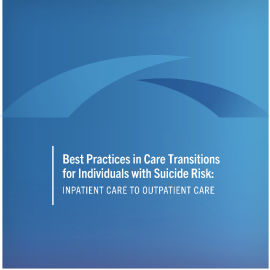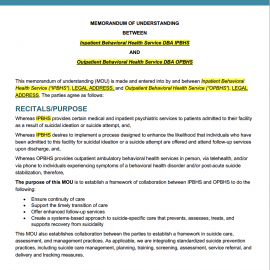Best Practices
Ensuring Safe Care Transitions
Effective care transition practices require innovative approaches to create an experience of smooth and uninterrupted care from one setting to another. We know that the first few days after discharge from an inpatient psychiatric facility are the riskiest time for individuals, particularly if they have had a recent suicide attempt. It is important to “narrow the gap” between care environments as much as possible -- and that can be difficult when there are availability and access issues. However, there are many actions that can be taken to help support individuals at risk of suicide during times of transition.
Inpatient to Outpatient
Specifically, the referring inpatient provider should:
- Collaboratively revise the individual’s safety plan before discharge
- Provide lethal means counseling or review plan to reduce access to lethal means before discharge (i.e., particularly related to firearms and any medication provided to the individual
- Encourage participation from family or other supportive persons who can help the individual in the intervening time until their appointment with their new provider
- Obtain releases of information from the individual for the new provider and any other supports to facilitate the transition and address any barriers
- Include a peer specialist, if available
- Ensure the individual has had direct contact with the new provider through a warm handoff and has all pertinent information to attend the appointment (e.g., date, time, transportation
- Send records to the new provider several days in advance of the appointment
- Provide a caring contact within the first 24 hours following discharge
- Contact the individual within 24-48 hours after their appointment with new provider to ensure they have transitioned and document the contact
Other Transitions
Other referring providers (e.g., primary care to behavioral health, clinic to clinic, program to program) should:
- Collaboratively update the individual’s safety plan before referral (if a safety plan was done)
- Provide lethal means counseling or review plan to reduce access to lethal means before discharge (i.e., particularly related to firearms and any medication provided to the individual)
- Obtain release of information from individual to enable direct communication, if necessary, between the referring and new provider
- Ensure the individual has had direct contact with the new provider through a warm handoff
- Address any potential barriers to attending the appointment with the individual (e.g., transportation)
- Send records to the new care provider several days in advance of the appointment
- Contact the individual and/or the new provider within 24-48 hours to confirm transition and document the contact
- Follow up with the individual if the appointment was not kept and provide additional support, address barriers, etc.
Also, every step of the care transition process should be properly categorized and documented in the referring and receiving organizations’ records. It is helpful for the triage process and for data collection to identify the type of referral in the EHR (e.g., hospital discharge, step-down transition). This can help staff provide the right level of triage, screening, and assessment at the initial appointment. Any records that are received from referring organizations should be readily available to the receiving provider, preferably in the EHR, so they can be reviewed prior to the first appointment. If a release of information is not included with the records, the receiving provider should obtain one from the individual to ensure permission for any further communication between providers.
Recommended Evidence-Based and Best Practices
Warm Hand-Off
The goal of a warm hand-off is to increase the likelihood that an individual will attend and engage in treatment with the new provider. A warm hand-off can reduce anxiety, calm fears, and create a human connection before the individual even connects with the new provider’s office.
“Look at each step or practice as part of a larger, holistic approach to working toward the health and safety of each patient by cultivating connections. Encourage contact between the outpatient provider and the patient prior to discharge. Find ways to build connections among the patient, family, and the natural supports."
—Best Practices in Care Transitions for Individuals With Suicide Risk, Action Alliance for Suicide Prevention
Rather than simply providing the name and phone number of a provider and leaving it up to the individual to schedule their follow-up care, as happens frequently, a warm hand-off connects the individual with the new provider before discharge. This can be done in a number of ways. An inpatient staff member can call the new provider with the individual and facilitate the follow-up appointment. This way any known barriers to attending the appointment can be addressed immediately. Some facilities have peer support workers who can be an intermediary for individuals who are uncomfortable making and attending an appointment at a new provider, particularly if this is their first time attending outpatient behavioral health treatment. The peer support worker can facilitate the warm hand-off or provide support to the individual throughout the transition process. Hospital Sisters Health System & Prevea Health uses a creative warm hand-off process that includes showing recorded video messages from outpatient providers at the receiving organization to individuals who will be transitioning from inpatient to outpatient care.
Listen to Executive Director of Behavioral Health and Zero Suicide Institute faculty member Toni Simonson speak about this process below:
Rapid Referral and Follow-Up
Rapid referral and follow-up involve taking steps during an emergency department visit, primary care visit, or before discharge from inpatient care to facilitate immediate access to an outpatient treatment appointment, preferably within 24-48 hours after referral or discharge. It is helpful if there is a collaborative agreement between providers that formalizes procedures and expectations. Organization policies should establish processes for:
- Scheduling the first outpatient appointment before discharge if the outpatient provider is reachable.
- Leaving a message with the outpatient provider to request an appointment upon discharge if the provider is not reachable. There should be guidelines for following up with the receiving provider after leaving this message to ensure there is a solidified next step in care for the individual at risk of suicide.
- The organizations should clarify who is responsible for questions or medication issues between discharge and the first appointment with the new provider.
Caring Contacts
Caring contacts are brief communications with individuals during care transitions. These contacts demonstrate continued support from care providers. They can strengthen an individual’s sense of connection to their care which can increase their collaborative participation. Caring contacts may be especially helpful for individuals who have barriers to accessing outpatient care. They should include supportive messages that do not require the individual to do anything. They aren’t a reminder to attend an appointment, or take medication, or use their safety plan. They are simple messages reminding the individual that there are people who care about them. Examples of caring contacts include:
- Postcards, letters, e-mail messages, voice mail messages, and text messages.
- Phone calls made by clinical or non-clinical staff, including peers who have experienced a suicide attempt. Individuals making phone contacts must be trained.
- Caring contacts are best sent from staff who the individual interacted with during the episode of care. It’s important that they are genuine, personalized messages of support and caring.
Here are some examples of caring contacts:
Other Bridging Strategies
The following are more examples of transition strategies:
- Brief education that helps individuals at risk of suicide understand their risks and the importance of follow-up care.
- Peer navigators who can assist individuals who are traversing the system of potential behavioral health supports. Sometimes it’s called peer- or community-bridging.
- Meetings or conversations with family members or other supports preferably prior to discharge to discuss the plan for the time period between care.
- Crisis service providers who provide support between appointments or episodes of care and can assess if acute care is needed at that time


